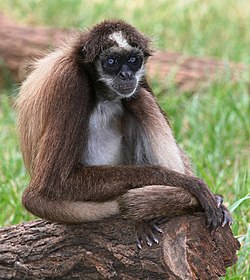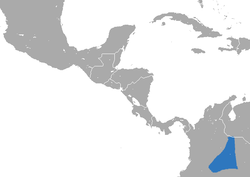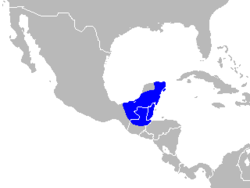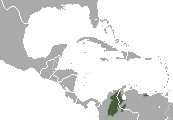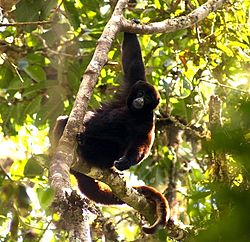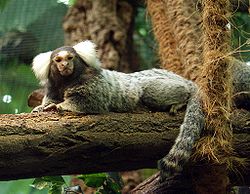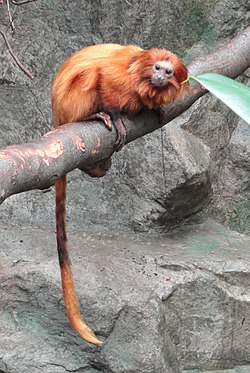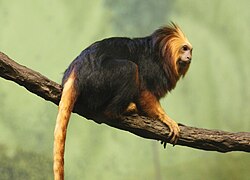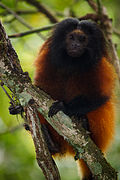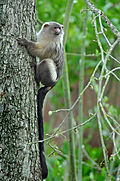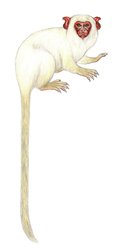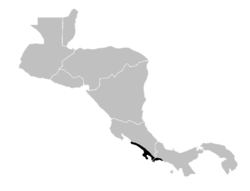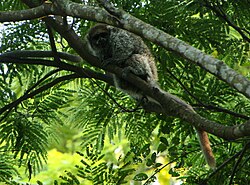| Common name | Scientific name and subspecies | Range | Size and ecology | IUCN status and estimated population |
|---|
| Brown-mantled tamarin  | S. fuscicollis
Spix, 1823
- S. f. avilapiresi (Avila Pires' saddle-back tamarin)
- S. f. fuscicollis (Spix's saddle-back tamarin)
- S. f. mura (Mura's saddleback tamarin)
- S. f. primitivus (Lako's saddleback tamarin)
| West-central South America
 | Size: 21–23 cm (8–9 in) long, plus about 43 cm (17 in) tail [128]
Habitat: Forest [129]
Diet: Fruit, flowers, nectar, gum, sap, frogs, snails, lizards, spiders, and insects [129] | LC
Unknown  [129] [129]
|
|---|
| Black-mantled tamarin  | S. nigricollis
Spix, 1823
- S. n. graellsi (Graells's tamarin)
- S. n. hernandezi (Hernandez-Camacho's black-mantle tamarin)
- S. n. nigricollis (Spix's black mantle tamarin)
| West-central South America
 | Size: 22–23 cm (9 in) long, plus 35–37 cm (14–15 in) tail [130]
Habitat: Forest [131]
Diet: Insects, fruit, seeds, flowers, nectar, and gum [130] | LC
Unknown  [131] [131]
|
|---|
| Black tamarin  | S. niger
(Geoffroy, 1803) | Eastern South America
 | Size: 17–31 cm (7–12 in) long, plus 25–44 cm (10–17 in) tail [91]
Habitat: Forest [132]
Diet: Fruit, flowers, nectar, gum, sap, frogs, snails, lizards, spiders, and insects [132] | VU
Unknown  [132] [132]
|
|---|
| Cotton-top tamarin  | S. oedipus
(Linnaeus, 1758) | Northwestern South America
 | Size: 20–25 cm (8–10 in) long, plus 33–40 cm (13–16 in) tail [82]
Habitat: Forest [133]
Diet: Insects, fruit, and gum [134] | CR
2,000  [133] [133]
|
|---|
| Eastern black-handed tamarin
| S. ursula
Hoffmannsegg, 1807 | Eastern South America
 | Size: 17–31 cm (7–12 in) long, plus 25–44 cm (10–17 in) tail [91]
Habitat: Forest [135]
Diet: Fruit, flowers, nectar, gum, sap, frogs, snails, lizards, spiders, and insects [135] | VU
Unknown  [135] [135]
|
|---|
| Emperor tamarin  | S. imperator
(Goeldi, 1907)
| Western South America
 | Size: 23–27 cm (9–11 in) long, plus 35–43 cm (14–17 in) tail [136]
Habitat: Forest [137]
Diet: Fruit, insects, and tree sap, as well as lizards, tree frogs, and bird eggs [136] | LC
Unknown  [137] [137]
|
|---|
| Geoffroy's tamarin  | S. geoffroyi
(Pucheran, 1845) | Northwestern South America and southeastern Central America
 | Size: 20–29 cm (8–11 in) long, plus 31–42 cm (12–17 in) tail [138]
Habitat: Forest [139]
Diet: Fruit, flowers, nectar, gum, sap, frogs, snails, lizards, spiders, and insects [139] | NT
Unknown  [139] [139]
|
|---|
| Golden-handed tamarin 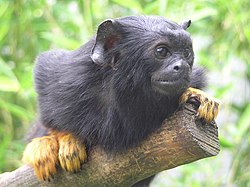 | S. midas
(Linnaeus, 1758) | Northeastern South America
 | Size: 20–28 cm (8–11 in) long, plus 31–44 cm (12–17 in) tail [140]
Habitat: Forest and savanna [141]
Diet: Fruit, flowers, nectar, gum, sap, frogs, snails, lizards, spiders, and insects [141] | LC
Unknown  [141] [141]
|
|---|
| Golden-mantled tamarin  | S. tripartitus
H. Milne-Edwards, 1878 | Western South America
 | Size: 21–24 cm (8–9 in) long, plus 31–35 cm (12–14 in) tail [142]
Habitat: Forest [143]
Diet: Fruit, flowers, nectar, gum, sap, frogs, snails, lizards, spiders, and insects [143] | NT
Unknown  [143] [143]
|
|---|
| Martins's tamarin
| S. martinsi
(Thomas, 1912)
- S. m. martinsi (Martin's bare-face tamarin)
- S. m. ochraceus (Ochraceous bare-faced tamarin)
| Central South America
 | Size: 17–31 cm (7–12 in) long, plus 25–44 cm (10–17 in) tail [91]
Habitat: Forest [144]
Diet: Fruit, flowers, nectar, gum, sap, frogs, snails, lizards, spiders, and insects [144] | NT
Unknown  [144] [144]
|
|---|
| Mottle-faced tamarin  | S. inustus
(Schwartz, 1951) | West-central South America
 | Size: 17–31 cm (7–12 in) long, plus 25–44 cm (10–17 in) tail [91]
Habitat: Forest [145]
Diet: Fruit, insects, and spiders [145] | LC
Unknown  [145] [145]
|
|---|
| Moustached tamarin 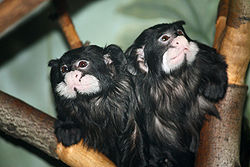 | S. mystax
(Spix, 1823)
- S. m. mystax (Spix's moustached tamarin)
- S. m. pluto (White-rumped moustached tamarin)
| West-central South America
 | Size: 24–25 cm (9–10 in) long, plus about 38 cm (15 in) tail [146]
Habitat: Forest [147]
Diet: Fruit, flowers, nectar, insects, sap, gum, and soil [148] | LC
Unknown  [147] [147]
|
|---|
| Pied tamarin  | S. bicolor
Spix, 1823 | Central South America
 | Size: 20–29 cm (8–11 in) long, plus 33–42 cm (13–17 in) tail [149]
Habitat: Forest [150]
Diet: Fruit, flowers, and sap, as well as gum and insects [149] | CR
Unknown  [150] [150]
|
|---|
| Red-capped tamarin  | S. pileatus
I. Geoffroy & Deville, 1848 | Central South America | Size: 17–31 cm (7–12 in) long, plus 25–44 cm (10–17 in) tail [91]
Habitat: Forest [151]
Diet: Fruit pulp, sap, nectar, invertebrates, and small vertebrates [151] | LC
Unknown  [151] [151]
|
|---|
| White-footed tamarin  | S. leucopus
(Günther, 1877) | Northwestern South America
 | Size: 17–31 cm (7–12 in) long, plus 25–44 cm (10–17 in) tail [91]
Habitat: Forest
Diet: Fruit, flowers, nectar, gum, sap, frogs, snails, lizards, spiders, and insects | VU
Unknown 
|
|---|
| White-lipped tamarin 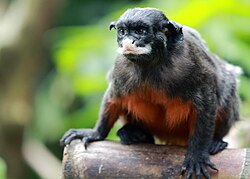 | S. labiatus
(Humboldt, 1812)
- S. l. labiatus
- S. l. rufiventer
- S. l. thomasi (Thomas' moustached tamarin)
| Central South America
 | Size: 17–31 cm (7–12 in) long, plus 25–44 cm (10–17 in) tail [91]
Habitat: Forest [153]
Diet: Fruit, nectar, insects, and sap [154] | LC
Unknown  [153] [153]
|
|---|
| White-mantled tamarin  | S. melanoleucus
Miranda-Ribeiro, 1912 | West-central South America
 | Size: 17–31 cm (7–12 in) long, plus 25–44 cm (10–17 in) tail [91]
Habitat: Forest [155]
Diet: Fruit, flowers, nectar, gum, sap, frogs, snails, lizards, spiders, and insects [155] | LC
Unknown  [155] [155]
|
|---|
